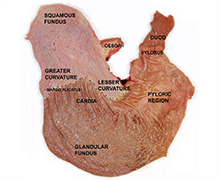Emergency Equine Vet:
Breadstone: 01453 811867
Failand: 01275 392956
Stretcholt: 01278 229129
Willesley: 01666 880501
Gastroscopy describes a complete examination of the two lining tissues of the horses stomach using a 3.5m flexible video-endoscope. It is performed under light sedation and images are captured at specific points around the stomach and are graded and defined by type.
Equine gastric ulcer syndrome (EGUS) is something we see more and more frequently. If your horse is under performing, has behavioural changes, has a poor appetite, poor coat condition or pain on girthing then they may be suffering from gastric ulcers. Usinggastroscopy to visualise the horse's stomach, we are able to see whether ulcers are present or not and also which type. Once diagnosed, we can offer the most appropriate treatment.
There are two main forms of gastric ulcer:
 Primary squamous ulceration, which occurs in the white top half of the stomach as a result of increased acid exposure. This condition is more common in racehorses (up to 90%), and typically causes slowed eating, variable appetite, weight loss and poor performance. It is less common in sport and leisure horses (30%). Known risk factors are daytime forage deprivation, high concentrate diets, prolonged exercise on an empty stomach and recurrent transport.
Primary squamous ulceration, which occurs in the white top half of the stomach as a result of increased acid exposure. This condition is more common in racehorses (up to 90%), and typically causes slowed eating, variable appetite, weight loss and poor performance. It is less common in sport and leisure horses (30%). Known risk factors are daytime forage deprivation, high concentrate diets, prolonged exercise on an empty stomach and recurrent transport.After gastroscopy, a specific treatment regime is devised based upon the location, severity and type of ulceration found, in addition targeted advice on changing management and feeding practice is given in order to improve gastric health and limit future ulcer development. Most horses are treated for 28 days, after which gastroscopy is repeated. Complete healing occurs in most cases seen at B&W, with less than 5% having long term ulcer recurrence.
At B&W we have completed around 300 gastroscopies a year since 2004 and are actively involved in researching this condition in sport and leisure horses.